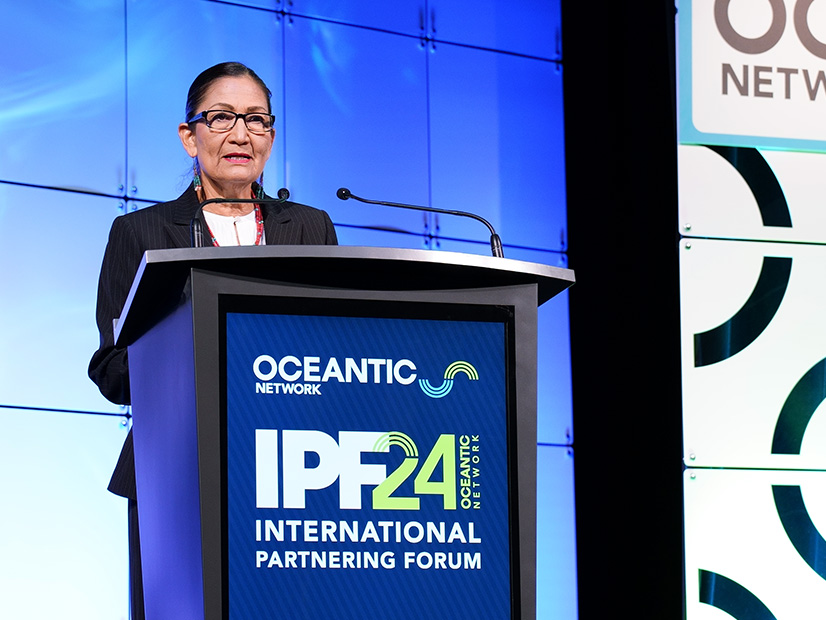
NEW ORLEANS — The U.S. Department of the Interior has set a new five-year schedule for as many as a dozen new offshore wind energy lease auctions and finalized an update of its regulations for renewable energy development in U.S. waters.
Secretary of the Interior Deb Haaland announced the news April 24 at the 2024 International Partnering Forum, where more than 3,000 stakeholders and prospective stakeholders gathered for an update on the offshore wind industry.
“The updated rule modernizes existing regulations and streamlines and eliminates those that are overly complex or unnecessary,” she said, building on lessons learned in the nearly 15 years since the original rule’s issuance.
Haaland added that it “will ensure that we build out the offshore wind industry effectively and efficiently at the pace that our future demands, [with] safety and environmental protections at top of mind.”
Also April 24, the Department of Energy issued its “Pathways to Commercial Liftoff: Offshore Wind” report and announced $48 million in funding for R&D projects for the sector.
The Biden administration has set a goal of 30 GW of offshore wind installed by 2030 and 15 GW of floating wind installed by 2035. DOI and its Bureau of Ocean Energy Management have pursued this vigorously, and the department’s announcements took an enthusiastic tone.
“There will be bumps in the road but together I know we can achieve great things,” Haaland said. “The offshore wind industry is here. And it’s here to stay.”
Regulatory Update
The updated framework for renewable energy development on the U.S. Outer Continental Shelf was issued April 24 as the “Renewable Energy Modernization Rule.”
In its announcement, Interior said the rule “increases certainty and reduces the costs associated with the deployment of offshore wind projects by modernizing regulations, streamlining overly complex processes and removing unnecessary ones, clarifying ambiguous regulatory provisions, and enhancing compliance requirements.”
Interior estimates the U.S. offshore wind industry will realize $1.9 billion in savings over the next 20 years as a result.
The final rule will be published in the Federal Register in the coming days. The unofficial text and a fact sheet already are online.
Its executive summary identifies eight key provisions with the following benefits:
-
- eliminates unnecessary requirements for meteorological buoy deployment;
- increases survey flexibility;
- improves the facility design, fabrication and installation certification and verification process;
- establishes a public renewable energy leasing schedule;
- reforms BOEM’s renewable energy auction regulations;
- tailors financial assurance requirements and instruments;
- clarifies safety management system regulations; and
- clarifies and strengthens oversight of critical safety systems and equipment.
Auction Schedule
The wind lease sale schedule that Interior announced is extensive, stretching from the Atlantic to the Gulf of Mexico to the Pacific and even a U.S. territory.
In the announcement, Haaland took a poke at President Biden’s predecessor and potential successor, former President Donald Trump, saying the Trump administration stalled the start of offshore wind in U.S. waters and the Biden administration has expedited it.
“Routinely issuing a leasing schedule demonstrates our commitment to a long-term portfolio of leases and provides advance notice to stakeholders of the areas that are being considered for future lease sales, and facilitates planning by tribes, states, localities, interest groups, academia, nonprofits, fisheries, federal agencies and other stakeholders,” BOEM Director Elizabeth Klein said in the announcement.
The new schedule lays out a roadmap for 12 lease sales:
-
- 2024: Central Atlantic, Gulf of Maine, Gulf of Mexico, Oregon.
- 2025: Gulf of Mexico.
- 2026: Central Atlantic.
- 2027: Gulf of Mexico, New York Bight.
- 2028: California, a U.S. territory, Gulf of Maine and Hawaii.
An overview posted online indicates the 2024 Central Atlantic auction will be first, followed by the Gulf of Mexico auction in September and the Oregon and Gulf of Maine auctions in October.
BOEM will continue to work with the Intergovernmental Renewable Energy Task Forces to coordinate potential lease sales.
Liftoff Report
The Liftoff report acknowledges the well-publicized challenges facing offshore wind, which has suffered contract cancellations, cost increases and project delays. But it paints an optimistic picture:
“Despite recent macroeconomic challenges, the sector is adapting, and improved risk mitigation is being built into industry planning. U.S. offshore wind is now poised for Liftoff, beginning with the 10–15 GW of projects with a path to final investment decision in the next few years.”
Deputy Secretary of Energy David Turk, who took the stage before Haaland at IPF24 on April 24, said in the official announcement: “The offshore wind sector is making rapid progress even in the face of macroeconomic challenges, poising the industry to create good jobs and supporting a clean, resilient energy system.”
The cost increases slamming the offshore wind industry in the past few years have begun to ease and there is a path to cost reductions, the report says.
Offshore wind presents a compelling value proposition, the report states: It advances decarbonization goals, offers a good capacity factor and can bolster the economy’s maritime and domestic manufacturing sectors.
The report says the potential exists for a U.S. buildout exceeding 100 GW by 2050.
Arrayed against that potential are four key challenges: Recent offtake cancellations, risky market structures, difficulty with long-term planning visibility and, of course, transmission constraints. But multiple potential solutions are in play for each, the report indicates.
The liftoff report and a one-page summary are available online. The Department of Energy has scheduled a webinar on the report for May 10.
Additional IPF24 Coverage
Read NetZero Insider’s full coverage of the 2024 International Partnering Forum here:
Central Atlantic Region Prepares for OSW Development
How Best to Address OSW’s Effects on Fisheries
Louisiana Manufacturers Expand into Offshore Wind
Moving Offshore Wind Beyond Contract Cancellations
New York Starts Another OSW Rebound


